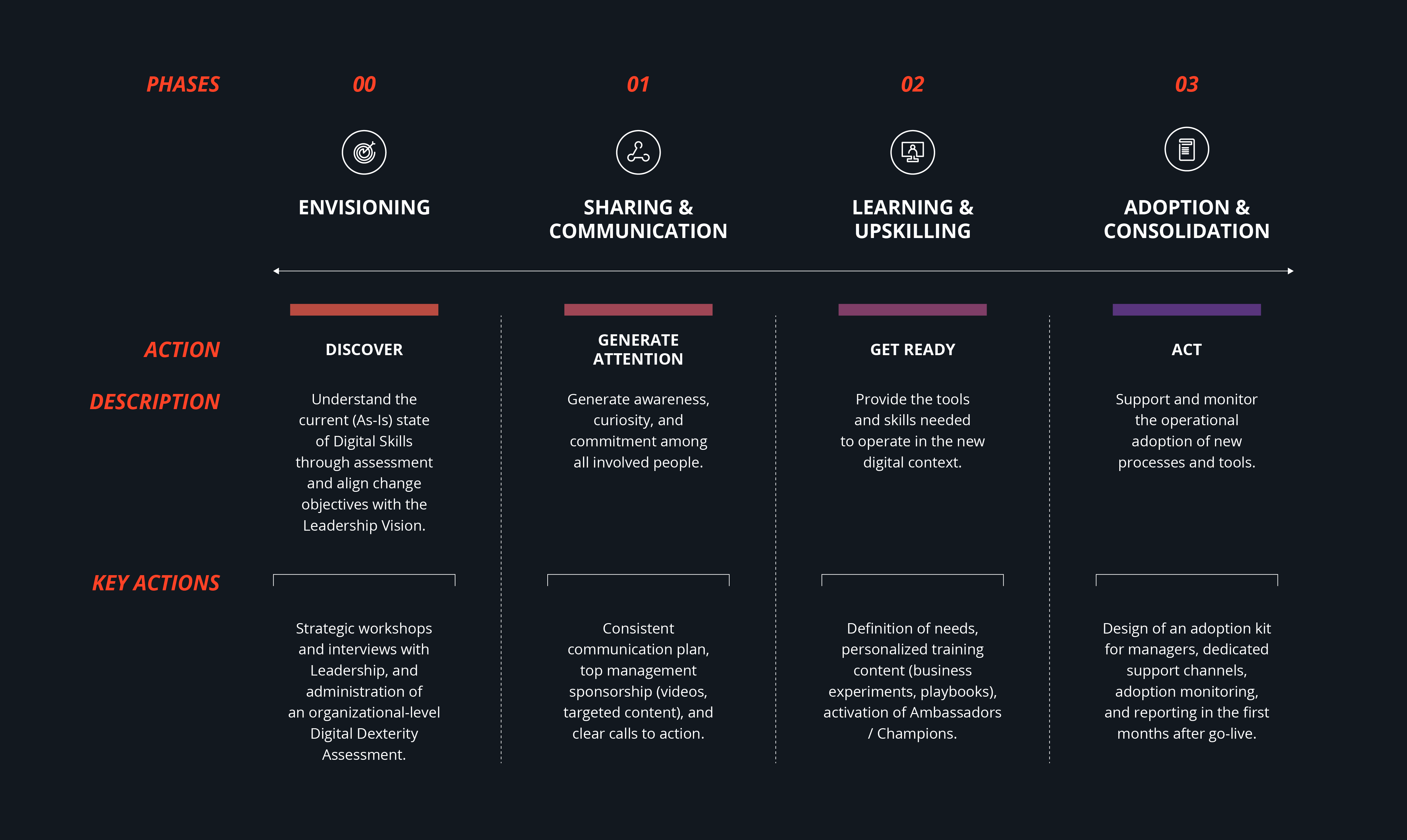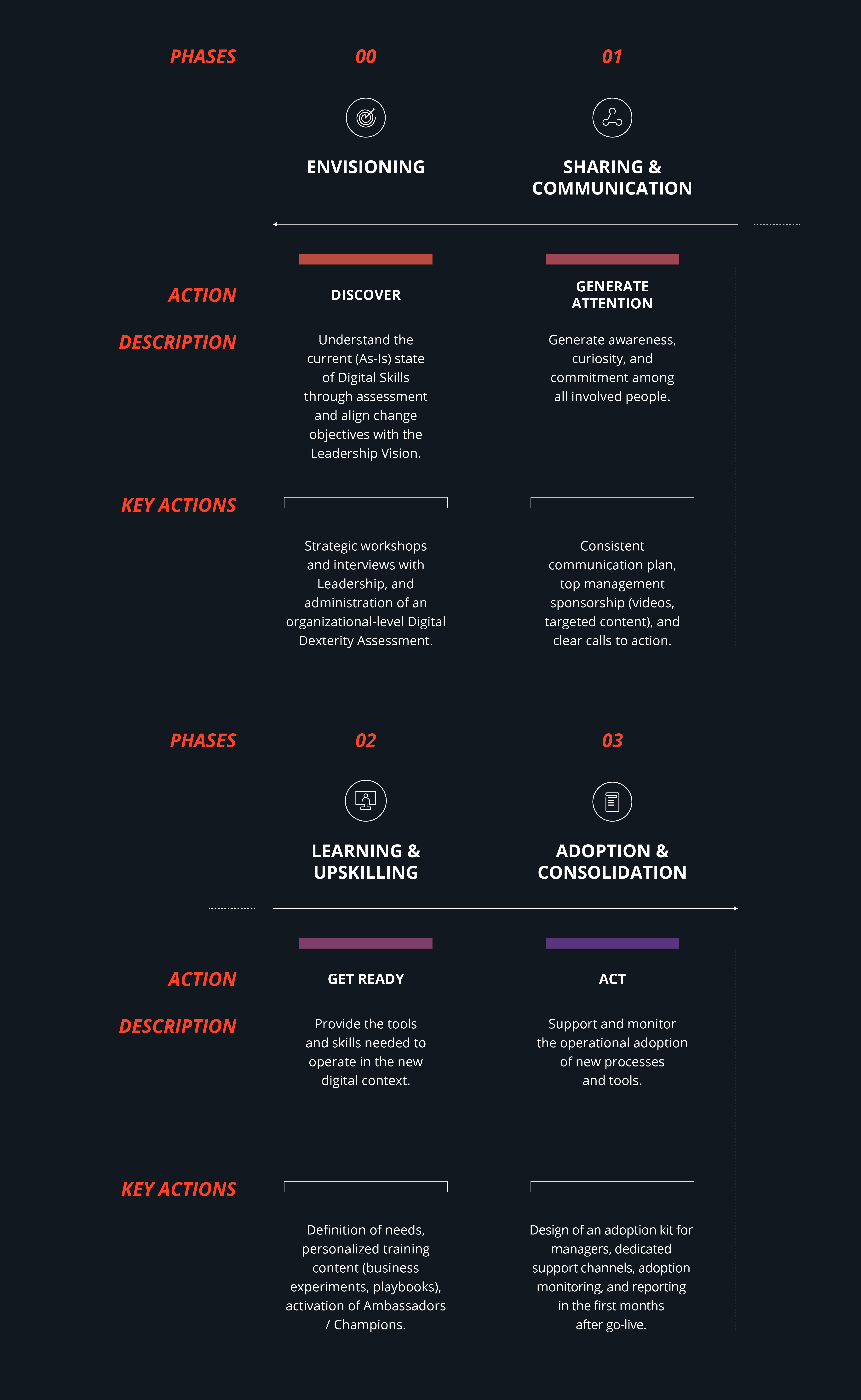From Digital Literacy to Digital Dexterity:
The Strategic Shift to Unlock Organizational Digital Potential
In today’s fast-moving and unpredictable business landscape where technological change accelerates by the day, it’s no longer enough for organizations to simply use technology. They must learn to leverage it strategically, proactively, and transformatively. This ability, which lies at the heart of true digital transformation, is known as Digital Dexterity.
The Strategic Leap Beyond Literacy and Transformation
Digital Dexterity marks a crucial evolutionary leap, from basic technological know-how to true mastery.
While Digital Literacy refers to the foundational ability to use technology, like operating software or devices, Digital Dexterity moves to a higher plane. It’s not a theoretical distinction but a practical one: a digitally literate employee can complete a spreadsheet; a digitally dexterous one can integrate that same spreadsheet with a Generative AI tool to rethink the entire data analysis process, scaling results beyond traditional methods and achieving greater output with the same resources.
This shift, from passive use to strategic and creative application of technology, is what drives successful digital transformation.
But true mastery requires more than technical competence. It demands cultural and psychological engagement. Digital Dexterity grows from a proactive, flexible mindset and an unwavering readiness to adapt to new tools, adopting a digital-first approach to problem-solving. Creativity, self-efficacy, and an innovative spirit make the difference, turning employees from tool users into change-makers.
The Cost of Inertia and the Human Factor
Research shows that achieving Digital Dexterity is about 75% a human and organizational challenge, and only 25% a matter of technology adoption. Companies often struggle because they overinvest in tools and systems but underinvest in integrating them into culture, skills, and strategy.
Gartner data reveals that only 9% of employees in digital organizations can be considered highly dexterous (Gartner, 2018). A small figure, given that Digital Dexterity shouldn’t be confined to IT, it should flow across every department and function.
Executive Leadership: The Engine of a Digital Mindset
No Digital Dexterity framework can thrive without solid leadership and dedicated executive support. Leaders aren’t just sponsors, they must be active participants, shaping and embodying a digital-first culture.
Their role unfolds in two key ways:
Modeling Behavior
Leaders must walk the talk, demonstrating digital dexterity themselves. They should stay alert to emerging threats and opportunities, and lead by example in using digital tools to overcome challenges. Data-driven decision-making should become second nature across the organization.
Fostering Culture
By modeling these behaviors, leaders inspire teams to build similar capabilities. They must promote shared accountability, break down silos, and nurture a culture of collaboration and proactivity.
Without consistent and visible commitment from the C-suite, employees won’t fully grasp the strategic value of evolving their digital skills. That’s why training, upskilling, and reskilling are vital, not just to build technical capability, but to spark curiosity, initiative, and openness to change.
Generative AI and the Expanding Dexterity Divide
The rise of Generative AI represents both the biggest challenge and the greatest accelerator for Digital Dexterity. It creates value but also exposes existing skill gaps.
Gen AI has proven to save time and drive measurable productivity gains across the workforce. Studies show that employees using it save an average of 5.4% of their weekly working hours, roughly 2.2 hours a week. However, the benefits aren’t evenly spread: workers in digitally advanced fields use Gen AI for nearly 12% of their time, compared to just 1.3% for others (Blandin, Bick, & Deming, 2024).
This highlights Gen AI’s dual role: a catalyst for effective digitalization and a spotlight on dexterity gaps that call for targeted investment.
In an era marked by uncertainty and constant change, Digital Dexterity stands as a decisive competitive advantage. Companies that nurture it are more resilient, faster to react, and better equipped to seize new opportunities.
The OpenKnowledge (BIP Red) Perspective: Cultivating Readiness for the Next Step
Once the strategic imperative of Digital Dexterity is clear, one question remains: are we cultivating a culture that can make adaptive choices every day, even when circumstances shift suddenly?
That’s where OpenKnowledge begins. As part of BIP Red, the Creative Technology Studio within the BIP Group, we support companies on their transformation journeys, blending strategy, design, and technology to drive cultural change and create tangible impact. Our approach to Digital Dexterity is systemic, built on the belief that true adoption isn’t about tools, it’s a human and organizational challenge.
We don’t just deliver software or standard training. We work on the mindset that prepares organizations for their next leap, intertwining meaning, behavior, and tools through tailored, co-designed programs.
Transformation becomes sustainable, not sporadic, only when three core levers move in harmony:
Cultural Identity and New Behaviors (Cultural Change)
Culture lives through everyday behavior. That’s why we focus on activating leadership and key stakeholders to visibly communicate their commitment and embody the project’s purpose.
Through symbolic actions, celebrating achievements, engagement activities, and meaningful shared moments, we help organizations build a narrative that reinforces cultural identity and turns digitalization into a daily, enduring reality.
New Processes, Technologies, and Ways of Working
Technology adoption works best when workflows naturally invite new ways of working. We help organizations adopt tools, processes, and policies that are easy to understand, align with business goals, and fit seamlessly into daily routines. We encourage modern approaches to hybrid work, collaboration, and sharing, making the “new way” simpler, smarter, and more productive.
Skills and Mindset (Skill, Upskill & Reskill)
Modern skills and a continuous learning mindset develop only through hands-on experience. Our employee-centered approach, guided by #EMPLOYEE, #MINDSET, #SKILL, focuses on practical learning.
We drive adoption through ambassador networks, cascading engagement, and experiential “learning by doing.” Curiosity becomes habit. Mistakes turn into learning material. The workplace becomes an environment that enables data-driven, collaborative choices.
The OpenKnowledge Method: From Shared Purpose to Everyday Practice
Our transformation methodology follows a clear, phased framework that ensures alignment, support, and continuous progress monitoring.
Envisioning: Understanding the current level of digital dexterity through data-driven assessments and aligning goals with leadership’s vision.
Sharing & Communication: Creating awareness, curiosity, and commitment across the organization through clear, engaging communication and visible executive sponsorship.
Learning & Upskilling: Providing personalized learning paths and innovative content to equip people with the right tools and confidence to act.
Adoption & Consolidation: Supporting implementation through monitoring, feedback, and continuous reinforcement, so new habits and tools take root naturally.

Source: OpenKnowledge

Source: OpenKnowledge
The OpenKnowledge method ultimately creates ecosystems where culture, processes, and skills move in sync, where leadership drives meaning and teams feel genuine ownership of what they do. When that alignment happens, transformation stops being a one-time effort and becomes fertile ground for everyday progress.
Mastering Digital Dexterity is no longer optional. It’s the foundation of organizational resilience and the key to generating meaningful value in the digital age.
Authors
Benedetta Milani e Francesco Refoni

 14 October 2025
14 October 2025
